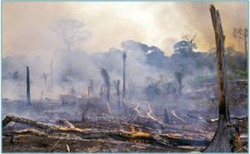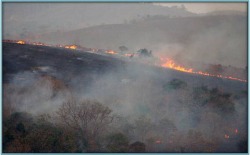RAINFOREST REMOVAL
There are varying methods and reasons for deforestation in South America; the reality is that removing trees affects the entire ecosystem and also surrounding locations. The effects of tree removal have known negative consequences and expected further devastations: to biodiversity, and soil and water quality. The landscape of the tropics is altered in order to increase economic gain, when in reality it is an unsustainable source of income and devastating to the globe.
Methods and Their Effects
There are many methods by which humans have developed to destruct the rainforest. The most commonly used methods are; slash and burn, selective logging, Clear-cut logging and, intensive agriculture, such as banana plantations. Asides from natural disasters the methods of removing forests have human-induced reasoning, usually resulting with some sort of capital gain. Though patches of forest have been cut down for different farming purposes for hundreds of years, it is not until recently that we have seen such massive destruction to the forests.
Slash-and-burn is the most widespread and ancient form of deforestation. The distinct quality of this method is the quick clearing of the forest with fire for agricultural purposes, followed by the cultivation of the land until all nutrients have been depleted. Farmers cut down trees and vegetation growing in the region, establishing the slash part of the process. Drying out the land is the next part; this usually takes place prior to the rainy season. Farmers may choose to add extra slashed fragments again after burning, to increase the fertility of the soil (Cornell).
Today slash-and-burn agriculture is mostly practiced in the tropical region. If practiced sustainably it can provide an inexpensive method of food production for a relatively overpopulated region of the earth. When executed properly slash-and-burn agriculture leaves a variety of the large trees in place that may or may not bear fruits or nuts. This imitates natural disasters and is therefore helpful for regeneration as opposed to mono-crop agriculture found in most northern countries.
Slash-and-burn, in its widespread use, is not always practiced sustainably. A lack of knowledge about the existent soil, climate and ecosystem tends to produce poor farming skills. Furthermore, if this method is not practiced properly in regions such as the Amazon forest it is popular for farmers to move to another location after exhausting one area. This is seen today where thousands of acres of forest canopy have been removed, and trees, millions of years old, are being destroyed.
Another method of deforestation is selective logging. It is considered a more sustainable means of tree removal over simple clear-cutting: here only certain targeted trees are cut down, leaving the remainder intact. The trees have to be a certain size and only a specific amount of trees are allowed to be cut down, permitting existing wildlife habitats to remain moderately stable. The assumption that regulated and controlled selective logging does not disrupt the majority of nature is offset with: "a new satellite survey of the Amazon Basin in Brazil reveals that every year unregulated selective logging of mahogany and other hardwoods destroys an area of pristine rainforest big enough to cover the state of Connecticut." These findings suggest that regulations are perhaps not being met (Shwartz).
Clear-cutting is the most vicious and devastating technique of deforestation: it is the clearing of all trees and vegetation in a specific region, to be converted to farmland or infrastructure. On occasion, there is not a specific use for the trees cut down. Clear-cutting affects the surrounding environment: it is responsible for the removal of entire forest canopies, destroying the habitat of thousands of biological diversity. Soil erosion, as seen in the Amazon, is included in the effects of clear-cutting. The Amazon soil is tightly bound by tree roots, which when removed exposes the soil to heavy rains. Soil is then carried to nearby rivers and streams causing irreparable damage to the quality of water and its aquatic life. Drinking water is also derived from the polluted waterway, for much of the surrounding population. Figure 2.2.1 (2) reveals the input of silt into the waterways, through soil erosion in the Amazon.
Finally, the method of intensive agriculture is characterized by economic pressures for increased crop yields. This method is practiced on relatively small plots of land that are highly controlled. Fertilizers, insecticides and, ploughing machinery are used in order to maintain the high efficiency. The resulting amounts of crop yielding from this extreme method usually necessitate a relatively small amount of land. Unfortunately, in order to cover the costs of the heavy machinery, fertilizers and pesticides, the farmers are encouraged to farm on larger plots.
Causes and Their Reasons
There are many reasons for humans to cut down forests; the majority are concerned with making a profit. The last several centuries have experienced a massive population growth all over the world. The demand for nearly every product on the market, and new ones, has increased exponentially. New large-scale companies, especially those driven by the government, view this as a means of gaining capital and reducing national debt. Governments therefore allow for such massive destruction of forests for agriculture, space to build infrastructure for manufacturing goods, and the straight sale of timber. All this is made accessible by the construction of roads throughout large forested areas, previously unavailable by foot. The largest and most devastating cause of deforestation in the Amazon forest is cattle ranching: between 2000 and 2005 approximately sixty percent of all deforestation resulted from it (Butler 3). The rainforest may contain some of the world’s secrets in regards to medicine, but due to the years of research and funding required – with no guaranteed results – governments would prefer to utilize the forest’s other resources. The rainforest is mined for its rich minerals and dams are built for hydroelectricity, both of which provide jobs for the inhabitants and boost the countries’ economies.
Biodiversity Extinction
Throughout history fossil records of many animals have helped shape several scientific theories of mass extinction due to global catastrophes. Today, the pace at which humans are destroying the world’s natural habitat is causing extinction at a rate comparable to that of the historic natural disasters.
The Amazon rainforest is home to some of the most diverse and rarest species on the planet. A few of these species exist only in one type of tree, not to be found anywhere else in the world (Butler 2). With this understanding, the reality of the amount of trees being removed without account of these site-specific species is devastating to rainforest biodiversity. Aside from the small insects living within the trees’ canopies, there are countless land-dwelling animals that require the forest in order to survive. Though deforestation may not kill them directly, there is proof that many are endangered and extinct by the encompassing effects of tree removal.


